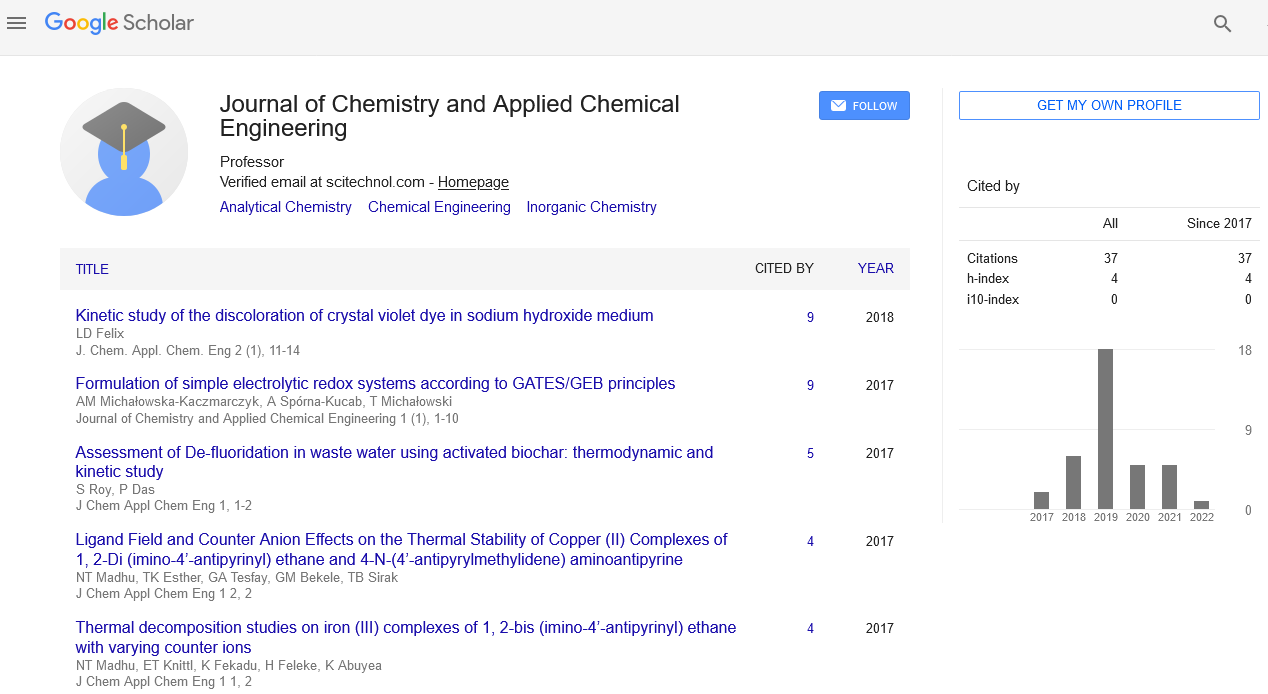Commentary, J Chem Appl Chem Eng Vol: 7 Issue: 2
Analyzing Reaction Pathways in Complex Reactions
Marc Coronado*
1Department of Molecular Science, University of Valencia, Paterna, Spain
*Corresponding Author: Marc Coronado,
Department of Molecular Science,
University of Valencia, Paterna, Spain;
E-mail: cocronadomarc@gmail.com
Received date: 23 May, 2023, Manuscript No. JCACE-23-106844;
Editor assigned date: 25 May, 2023, Pre QC No. JCACE-23-106844 (PQ);
Reviewed date: 08 June, 2023, QC No. JCACE-23-106844;
Revised date: 15 June, 2023, Manuscript No. JCACE-23-106844 (R);
Published date: 22 June, 2023, DOI: 10.4172/Jcace.1000029
Citation: Coronado M (2023) Analyzing Reaction Pathways in Complex Reactions. J Chem Appl Chem Eng 7:2.
Description
Chemical reaction pathways, also known as reaction mechanisms, are the step-by-step sequences of elementary reactions that occur during a chemical reaction. Understanding reaction pathways is essential for elucidating the underlying chemistry and kinetics of complex reactions. It allows chemists to predict and control reaction outcomes, design more efficient processes, and develop new synthetic routes for the production of desired compounds.
Chemical reaction pathways
Elementary reactions are individual steps that involve the breaking and forming of chemical bonds between molecules or atoms. These elementary reactions represent the smallest units of a chemical reaction pathway. During a chemical reaction, intermediate species are formed as transient products between consecutive elementary reactions. These intermediates often have short lifetimes and are difficult to observe directly.
The slowest elementary reaction in a reaction pathway, known as the rate-determining step, governs the overall rate of the reaction. It determines the rate expression and activation energy for the entire process. A reaction coordinate diagram, also known as an energy profile diagram, illustrates the energy changes along the reaction pathway. It provides insights into energy barriers, reaction energies, and the stability of intermediates.
Factors influencing reaction pathways
Higher temperatures can increase the reaction rate by overcoming energy barriers, promoting reactions along specific pathways. Conversely, lower temperatures may favor alternate pathways or inhibit reactions entirely. Catalysts facilitate reactions by providing an alternative reaction pathway with lower activation energy. They increase reaction rates and may lead to different reaction products. The concentrations of reactants can influence the likelihood of different reaction pathways. Higher concentrations of certain reactants may favor particular intermediates and products. The choice of solvent can impact the reaction pathway by stabilizing or destabilizing certain intermediates, influencing reaction rates, and affecting reaction selectivity.
Techniques for studying reaction pathways
Elucidating reaction pathways can be challenging due to the transient nature of intermediates. Several experimental and theoretical techniques are used to study reaction mechanisms.
• Various spectroscopic methods, such as UV-Vis, infrared, and NMR spectroscopy, provide valuable information about reaction intermediates and transition states.
• Mass spectrometry allows the identification and quantification of reaction products and intermediates, even at low concentrations.
• Kinetic measurements provide information about reaction rates and can help identify the rate-determining step.
• Theoretical calculations, such as Density Functional Theory (DFT) and ab initio methods, complement experimental data by providing insights into reaction energetics and transition states.
Significance of reaction pathways
Insight into reaction pathways aids in the design of more efficient catalysts, reducing energy consumption and waste generation in chemical processes. Understanding reaction pathways is essential in pharmaceutical research to optimize synthesis routes, control reaction selectivity, and improve the efficiency of drug production. Reaction pathways play a key role in the synthesis of advanced materials with tailored properties, such as polymers, nanoparticles, and composites. Studying reaction pathways helps in understanding pollutant transformations, atmospheric chemistry, and the development of environmental remediation strategies. In biochemistry, reaction pathways are essential for understanding metabolic processes, enzyme catalysis, and cellular signaling.
Reaction pathways and selectivity
The selectivity of a reaction refers to the preference for a specific product over alternative products. Understanding reaction pathways is vital for controlling selectivity, as different reaction intermediates can lead to distinct products. Catalysts and reaction conditions can be tuned to favor desired products in complex reactions, making reaction pathway analysis is essential in synthetic chemistry.
Reaction pathways in complex reactions
Complex reactions, such as multi-step organic synthesis and enzymatic processes, often involve intricate reaction pathways. Studying these pathways allows researchers to identify key intermediates and potential side reactions, leading to improved reaction efficiency and the discovery of novel compounds. Chemical reaction pathways are fundamental to understanding the mechanisms and kinetics of chemical reactions. They provide valuable insights into the energetics, intermediates, and selectivity of reactions, allowing chemists to design efficient synthesis routes and control reaction outcomes. Reaction pathway analysis is essential in various scientific fields, including drug development, materials science, and environmental chemistry. As experimental and theoretical techniques continue to advance, our understanding of reaction pathways will further contribute to the progress of chemistry and its applications in solving real-world challenges.
 Spanish
Spanish  Chinese
Chinese  Russian
Russian  German
German  French
French  Japanese
Japanese  Portuguese
Portuguese  Hindi
Hindi 